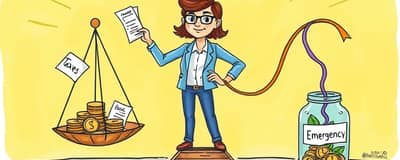Essential Financial Tips to Boost Your Savings Rate

In today’s unpredictable economic climate, cultivating a strong savings habit can offer both security and freedom. Whether you’re aiming to build an emergency cushion, fund a dream vacation, or prepare for retirement, the journey begins with clear goals and consistent action.
Throughout this article, you’ll discover practical steps to elevate your savings, backed by proven frameworks and real-world numbers. By applying these techniques, you’ll transform your finances and accelerate toward your objectives.
Set Clear Savings Goals
Every saving journey needs a destination. Start by defining your purpose—be it an emergency fund, a home down payment, or a future retirement plan. Allocating a specific target, such as saving $500 for emergencies within two months, provides clarity and motivation.
As you make progress, regularly review and adjust your goals. Life changes—new jobs, promotions, family needs—should prompt you to refine your targets. By staying flexible, you ensure your plan remains both relevant and inspiring.
Follow a Budgeting Rule
Adopting a simple budgeting framework can instantly clarify where your money should go each month. Popular standards guide you to balance necessities, wants, and savings in a disciplined way.
This table highlights three widely used approaches. Choose one that aligns with your lifestyle, then commit for at least three months. Seeing concrete percentages can keep you on track.
Track Your Spending and Cash Flow
Understanding exactly where your money goes is a cornerstone of financial success. Begin by listing every income source and expense category—from rent and utilities to streaming subscriptions and takeout coffee. Use budgeting apps or a customizable spreadsheet for accuracy and convenience.
Categorize nonessential expenses, such as dining out or entertainment, to pinpoint reduction opportunities. When you pay off a debt, immediately reallocate that freed-up cash to savings. Regularly updating your budget ensures you adapt when circumstances shift.
Make Saving Automatic
- Set up automatic transfers from checking to savings on payday.
- Use your employer’s direct deposit feature to split paychecks.
- Enroll in round-up programs that save spare change automatically.
Automation removes the temptation to spend what you planned to save. By treating transfers like mandatory bills, your savings will grow without effort, and you’ll steadily build momentum over time.
Maximize Where You Save
Not all savings accounts are created equal. Look for a high-yield savings account or money market option that offers competitive interest rates. Even a small difference—say 1% versus 0.1%—can translate into significant gains over a year.
Periodically compare rates at different institutions, including online banks. Shifting your balance to accounts with higher returns can be one of the easiest ways to boost your effective savings rate.
Increase Savings Rate Over Time
Start with a baseline of save 10–20% of your monthly income, then commit to growth. When you receive a raise, bonus, or tax refund, channel a portion directly into savings. If you eliminate a loan payment, continue depositing that amount each month.
This “pay yourself first” approach ensures that as your income grows, so does your savings balance—turning each milestone into an opportunity to accelerate your progress.
Control Spending to Save More
- Limit credit card use or set monthly spending caps.
- Use cash for discretionary purchases to curb impulses.
- Separate savings and checking accounts to reduce temptation.
Implementing these controls creates friction that discourages unnecessary purchases. Over time, harmless conveniences—like daily lattes—can become substantial contributions to your long-term goals.
Build and Maintain an Emergency Fund
An emergency fund acts as your financial safety net. Begin with a modest goal of $500–$1,000, then steadily build toward covering three to six months of essential expenses. Keeping this money in an accessible, interest-earning account ensures you’re ready for life’s surprises without jeopardizing your progress.
Resist the urge to tap into this fund for discretionary spending. Treat it purely as a shield against unforeseen events like medical bills, car repairs, or temporary job loss.
Practice Core Principles of Financial Literacy
True empowerment comes from mastering the foundational pillars of money management:
Earn: Maximize your income through side hustles, career advancements, or new skill development.
Spend: Budget diligently and eliminate recurring expenses that don’t serve your goals.
Save: Prioritize both short-term and long-term objectives with disciplined contributions.
Borrow: Refinance or pay off high-interest debts to free up more cash for savings.
Protect: Maintain adequate insurance and review coverage to safeguard your wealth.
By weaving these principles into your daily decisions, you cultivate financial resilience and clarity. Celebrate each milestone—whether it’s hitting your first $1,000 saved or fully funding six months of expenses. These wins fuel motivation and reinforce positive habits.
Finally, commit to regular check-ins. Quarterly or monthly reviews let you measure progress, adjust targets, and recognize opportunities to save more. With each iteration, you’ll hone a personalized system that not only boosts your savings rate but also empowers you to achieve lasting financial well-being.
Start today: define your goal, pick a budgeting framework, and automate your savings. Over time, these consistent actions will compound into substantial security and freedom, turning your financial aspirations into reality.
References
- https://www.nerdwallet.com/article/finance/how-to-save-money
- https://www.fidelity.com/viewpoints/personal-finance/spending-and-saving
- https://bettermoneyhabits.bankofamerica.com/en/saving-budgeting/ways-to-save-money
- https://blog.umb.com/personal-banking-tips-top-six-savings-tips-for-building-and-optimizing-your-savings-plan/
- https://www.intuit.com/blog/innovative-thinking/financial-tips/start-saving-money/
- https://www.vacu.org/learn/financial-management/saving-and-investing/10-savings-strategies
- https://www.investopedia.com/terms/f/financial-literacy.asp
- https://investor.vanguard.com/investor-resources-education/article/how-to-save






